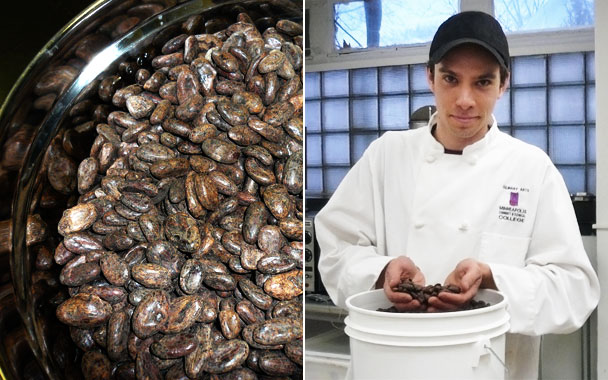Ever wonder why no one you know manufactures chocolate from raw cocoa beans? Right—neither had I until I spent an afternoon with 22-year-old Colin Gasko, who just debuted, he says, the smallest chocolate manufacturing plant in America, Rogue Chocolatier.
So far, Rogue makes just two chocolate bars, and they’re available only in the Twin Cities. But if you happen to have friends in Minnesota, demand that they mail one of each to you immediately. The Ocumare, from beans from the Ocumare Valley in northern coastal Venezuela, tastes massive, like a thundering old scotch, and reverberates on the palate with notes of black walnut, bacon, blackberry, blackcurrant liqueur, peat-smoked whiskey, and sourdough toast. The other bar, the Sambirano, which Gasko creates from beans sourced from northwest Madagascar, is Chianti-tart, with notes of raspberry tea, cedar, cinnamon, and burnt lemon peel.
As fabulous as Gasko’s chocolate bars are, what impressed me even more was the line of machinery he had invented or improvised to make them. Chocolate making is much more industrial than you’d imagine. The first steps are fairly comprehensible to any good cook: roasting the cocoa beans to individual taste, cracking them, and winnowing away the husks. Then things get hectic. Once you’ve got pure roasted chocolate nibs (nibs are the beans minus the husk) you have to basically pulverize them until every particle is between 20 and 30 microns across. Taking into account that a human hair is 100 microns across, you get the picture. We’re talking small. Evidently, anything bigger than 50 microns tastes gritty, and anything smaller than 15 microns tastes gummy, but we taste 20- to 30-micron chocolate particles floating in their own (or some added) cocoa butter as the miraculous beast called chocolate. The fact that this pulverizing (or, as they call it in the industry, melanging, conching, and milling) has to be done at a controlled heat (to keep fragile chocolate flavors intact) and can take several days only adds to the complexity of the process. I can’t reveal (or, truth be told, entirely understand) Gasko’s machine line (one of his key pieces is the modification of an Indian device originally developed to grind dosa flour). But he’s taken on an impossibly difficult task.
I’m glad Gasko is only 22, as I suspect anyone older and wiser would never have attempted to invent a small-scale chocolate manufacturing line from scratch. (Most neighborhood chocolatiers actually buy manufactured chocolate from a big operation like Valrhona, El Rey, or Scharffen Berger, and modify it from there.) Still, if this is the taste of youthful folly, I’ll take ten.
Rogue Chocolatier
2010 E. Hennepin Ave., Minneapolis




 Pinterest
Pinterest


